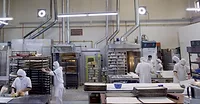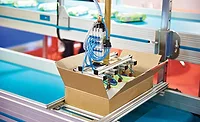Food Safety
A focus on education leads to better food safety outcomes

Don’t simply show employees the proper way to wash their hands; have them practice this key step in their training, and then explain the ways they could compromise food safety if they don’t follow the technique.
Image courtesy of Getty Images

One idea to make training hands-on and engaging: Have an employee touch petri dishes before and after handwashing to show the difference in germs.
Image courtesy of Getty Images
More than 30 years ago, Dr. Elizabeth Stier told me this:
“One trains a dog but educates a person.”
It is still very germane today. The implication of the statement is that when one trains, the persons being trained learn a task by rote. When the focus is education, people learn how to do a task or about a subject, why said task or subject is important, why it is essential a protocol be followed, and the potential concerns if the procedure is not followed. So, let’s talk about how to put together a great educational program in your facility.
First off, how extensive should a processor’s educational program be? There are many different elements that managements needs to be sure that employees understand. These are summarized as:
- Legal requirements: Management must be sure that all new employees are provided all information required by local, state and federal governments. This includes issues pertaining to company policies, taxes, vacations, etc. This must be done as part of the new employee orientation.
- Food protection principles: Management must develop programs to instruct workers on all aspects related to the food safety program. This includes, but is not limited to, the food safety program, food allergens, sanitation, personal hygiene, disease control, clothing, cleanliness, hair restraints and food hazards.
- Food handling procedures: Companies must provide all plant personnel with detailed instructions on how to perform all tasks pertaining to food preparation, food processing and handling, warehousing, ingredient storage and handling, shipping, and receiving. This would also include ensuring all persons involved with maintaining and monitoring the HACCP plan know how to do their work, why it is important and the consequences of failing to properly do this work.
- Plant sanitation: All persons involved with the sanitation program must be properly educated on how to clean and sanitize each and every piece of equipment, utensils, floors, walls, ceilings and overheads.
- Preventive maintenance: All employees involved in the maintenance program must understand how to maintain equipment.
- Worker safety: Management must teach all employees about worker safety. This includes, but is not limited to, proper lifting, lockout/tag out, forklift safety, safe chemical handling, repetitive motion injuries, slips and falls, personal protective equipment, and equipment safety. This is essential to minimize work-related injuries and to reduce potential liability.
Of course, there is no such thing as one size fits all. Each processor will have to develop programs that cater to its products, processes and facilities. As an example, a meat processor will have vastly different requirements than a fresh cut produce operator.
Emphasizing education helps ensure that a food processing facility operates efficiently and safely while producing foods that are high quality, safe and wholesome. It is simply good business.
Keys to good education
The most important element to ensuring the workers in food plants understand not only what is expected of them but how to do their jobs is to have well-documented policies, procedures and work instructions. All educational programs must be based on these documented procedures and policies.
There are reasons that protocols are written as they are and must be followed. For example, if production personnel fail to properly adhere to a protocol that is deemed a critical control point, the end result could be unsafe food. Or if someone fails to follow a validated cleaning procedure adopted for allergens, the end result could create a cross-contact situation.
Levels of education
There are three basic levels for the educational process in a food processing facility: orientation, job related and refresher sessions. Every new employee must be given an orientation. This is where the company will present the legal issues highlighted above. Another element that must be included in the orientation should be a basic introduction to food safety, sanitation, allergens, personal hygiene and other GMPs. This session must also address worker safety.
Looking for quick answers on food safety topics?
Try Ask FSM, our new smart AI search tool.
Ask FSM →
The refresher sessions should address these same elements. This is usually done by the food processor, but there are operations that utilize an employment agency when it comes to finding new or temporary employees. Some processors actually have the employment agency conduct the orientation, which improves overall efficiencies. The educational materials that the orientation is based upon are prepared by the processor, which should work closely with the agency to ensure that the orientation is conducted properly.
When developing educational materials for the orientation, processors should strive to help employees identify with the information being presented. The greater the involvement, the greater the comprehension. It is a bad idea to simply hand someone something to read, as is simply lecturing to people. Develop PowerPoint presentations, distribute them and make a concerted effort to get the participants involved.
Handwashing is one area that must be addressed during the orientation. It is also one element that lends itself to being hands on. (No pun intended.) Show the new employees the proper way to wash their hands and have them practice. In addition, utilize tools such as Glo Germ or petri dishes. With the latter, ask one of the participants to touch the petri dish with before and after handwashing. The person will transfer any bacteria on his or her fingers to the petri dish. After properly washing and sanitizing the hands, there should be few, if any, colonies to transfer. This visual demonstration is very effective when it comes to showing people that handwashing is not only effective, but that even clean hands are dirty. The participants learn the how, the why and the importance of handwashing.
Refresher sessions should be conducted every year. The focus is ensuring that the workforce, especially the line workers, are up to speed on food safety, sanitation, GMPs, allergens, personal hygiene and worker safety issues. Many operators will incorporate a means for evaluating the refresher sessions’ efficacy and people’s understanding of what is expected. The usual tool is a short test of 10-20 questions for each refresher element. If someone does not pass, managers will take the time to review the examination to ensure the person knows what is expected. If necessary, these sessions should be multilingual.
Job-related programs
The last type of educational program is job related. It is up to supervisors or managers to ensure that each and every employee understands what to do and how to do it. This is a challenge in that every task in the facility needs a properly documented procedure or work instruction.
These procedures and subsequent staff education must address each and every aspect of the food safety management system, such as prerequisite programs, food defense, HACCP or food safety plans and all aspects of sanitation. Teaching new employees or ones that are being moved to a new task can be done in different ways.
Some processors adopt a mentoring system where the new person works side by side with an experienced person. The mentor demonstrates how the task should be done, emphasizes the importance of following procedures, and will sign off when he or she believes the individual fully understands how to do the task.
One procedure that must be developed, documented and implemented, and clearly passed on to the person doing the work is how to monitor a critical control point (process preventive control) or any other preventive control. The person doing the work must not only be taught how to do the monitoring and record the necessary information, but the individual must understand why his or her job is important and the consequences of failing to do the work properly. This is one task that has become center stage in that auditors and regulatory investigators will challenge these persons when they are in-plant. The expectation is that the monitors will be able to fully describe their job and its importance.









